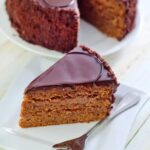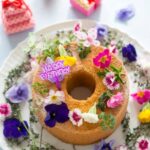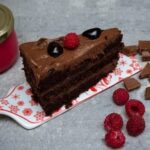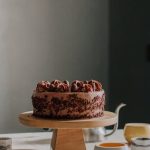Buttercream icing is a versatile and essential component when it comes to decorating cakes, especially for creating clean and precise edges. Knowing how to make buttercream icing for edge decorating cakes can elevate your baking skills and take your creations to the next level. This type of icing not only provides a smooth finish but also serves as a sturdy foundation for intricate designs and decorations on cakes.
Buttercream icing is beloved by bakers for its creamy texture and ability to hold its shape, making it perfect for edge decorating. With the right ingredients and techniques, you can achieve professional-looking results that will impress any cake connoisseur. Whether you are a seasoned baker looking to refine your skills or a beginner eager to learn the art of cake decorating, mastering buttercream icing is a crucial step in your culinary journey.
In this article, we will guide you through the process of making buttercream icing specifically designed for edge decorating cakes. We will break down the necessary ingredients, provide step-by-step instructions, offer tips for achieving the perfect consistency, explore coloring options, showcase different decorating techniques, and even share advice on storing any leftover icing.
Get ready to unleash your creativity and transform your cakes into edible works of art with our comprehensive guide on making buttercream icing for edge decorating.
Ingredients Needed for Making Buttercream Icing
Buttercream Icing Essentials
To make the perfect buttercream icing for edge decorating cakes, you will need a few essential ingredients. First and foremost, you will need unsalted butter at room temperature. It’s important to use unsalted butter so that you can control the amount of salt in your icing. Additionally, you will need sifted confectioners’ sugar (also known as powdered sugar) to achieve a smooth texture.
Liquid Ingredients
In addition to butter and confectioners’ sugar, you will also need some liquid ingredients to bring your buttercream icing together. Typically, a splash of vanilla extract is added for flavoring. You may also need a small amount of milk or heavy cream to adjust the consistency of the icing as needed. These liquid ingredients help create a creamy and spreadable texture for decorating purposes.
Addition of Salt
While this is optional depending on personal preference, some recipes call for a pinch of salt to enhance the overall flavor profile of the buttercream icing. The salt can help balance out the sweetness from the sugar and contribute to a more well-rounded taste.
However, it’s important not to overdo it with salt, as it can quickly overpower the other flavors in your icing. Feel free to experiment with different amounts until you find the perfect balance for your taste buds when making buttercream icing for edge decorating cakes.
Step-by-Step Instructions for Making Buttercream Icing
To make buttercream icing for edge decorating cakes, you will need a few key ingredients. You will need unsalted butter, powdered sugar, vanilla extract, and a pinch of salt. These ingredients work together to create a smooth and creamy icing that is perfect for decorating the edges of cakes.
First, start by creaming the unsalted butter in a mixing bowl until it is light and fluffy. This step is crucial as it sets the foundation for a smooth buttercream icing. Gradually add in the powdered sugar, a little at a time, while continuing to mix until well combined. The powdered sugar helps to sweeten the icing and give it structure.
Next, incorporate the vanilla extract and a pinch of salt into the mixture. The vanilla extract adds flavor to the buttercream icing, while the salt helps to balance out the sweetness. Mix everything together until you reach a smooth and creamy consistency. If the icing is too thick, you can add a bit of milk or cream to thin it out to your desired texture.
Once you have achieved the perfect consistency for your buttercream icing, you are ready to use it for edge decorating cakes. By following these simple steps, you can easily create delicious and visually appealing designs on your cakes that will impress your guests. With practice and patience, you can master the art of making buttercream icing for edge decorating cakes like a pro.
Tips and Tricks for Achieving the Perfect Consistency
Buttercream icing is a popular choice for decorating cakes due to its versatility and smooth texture. Achieving the perfect consistency is crucial when using buttercream icing for edge decorating, as it can make all the difference in the final result of your cake creation. How to make buttercream icing for edge decorating cakes involves paying attention to details such as the ingredients used and the mixing technique employed.
One essential tip for achieving the ideal consistency for edge decorating with buttercream icing is to ensure that your butter or shortening is at room temperature before starting. This will allow it to mix more easily with other ingredients and result in a smoother texture.
Another key factor in achieving the right consistency is gradually adding powdered sugar while mixing until you reach the desired thickness. This method helps prevent lumps in your buttercream and ensures a smooth finish on your cake edges.
Additionally, adjusting the amount of liquid added to your buttercream icing can help you achieve the perfect texture for piping intricate designs on cake edges. If your icing appears too thick and difficult to work with, adding a small amount of milk or cream can help soften it up.
On the other hand, if your icing is too thin and runny, incorporating more powdered sugar can help thicken it to the desired consistency. Experimenting with different ratios of ingredients will allow you to find the right balance for edge decorating with buttercream icing.
| Buttercream Consistency Tips | Methods |
|---|---|
| Room Temperature Ingredients | Mix butter or shortening at room temperature for a smoother texture |
| Gradual Powdered Sugar Addition | Add powdered sugar gradually until reaching desired thickness to avoid lumps |
| Adjusting Liquid Content | Add milk or cream to thin out thick icing or more powdered sugar to thicken runny icing |
Coloring Your Buttercream Icing
Coloring buttercream icing is a fun and creative way to add a pop of color to your cakes, cupcakes, and other baked goods. There are several methods you can use to achieve vibrant hues and shades in your buttercream.
One popular option is to use gel food coloring, which is more concentrated than liquid food coloring and won’t affect the consistency of your icing. Simply add a small amount of gel coloring at a time until you reach your desired shade.
Another method for coloring buttercream icing is to use natural ingredients like fruit purees or vegetable powders. For example, you can mix in raspberry puree for a pretty pink hue or spirulina powder for a lovely green color. These natural options not only add color but also flavor to your icing.
If you prefer a more pastel or subtle color palette, you can opt for airbrushing your buttercream icing. This technique involves using an airbrush gun with edible food colors to create a soft, gradient effect on your cakes. It’s a great way to achieve professional-looking results with ease. Experiment with different techniques and combinations to find the perfect colors for your next cake decorating project.
| Method | Description |
|---|---|
| Gel Food Coloring | Concentrated option that won’t affect consistency. |
| Natural Ingredients | Using fruit purees or vegetable powders for color and flavor. |
| Airbrushing | Create soft, gradient effects with an airbrush gun. |
Decorating Techniques With Buttercream Icing
Decorating cakes with buttercream icing offers a wide range of creative possibilities, especially when it comes to adding beautiful designs to the edges of the cake. Whether you are a beginner or an experienced baker, mastering different decorating techniques can take your cake projects to the next level. In this section, we will explore some unique and eye-catching designs that you can achieve using buttercream icing for edge decoration.
Ruffle Design
One popular technique for creating a delicate and elegant look on cake edges is the ruffle design. To achieve this effect, fill a piping bag fitted with a petal tip with your desired shade of buttercream icing. Hold the piping bag at a 45-degree angle to the edge of the cake and squeeze gently while moving back and forth in a zig-zag motion. This will create beautiful ruffles that add texture and visual interest to your cake.
Rosette Border
If you want to add a touch of romance and charm to your cake edges, consider using the rosette border technique. Simply attach a star-shaped piping tip to your piping bag filled with buttercream icing and pipe small swirls around the edge of the cake. Start from the outer edge and work your way towards the center, overlapping slightly as you go. The result is a stunning border of delicate rosettes that can elevate any cake design.
Basketweave Pattern
For a more intricate and sophisticated look, try creating a basketweave pattern on the edges of your cake using buttercream icing. Fill one piping bag with a small round tip for outlining and another piping bag with a basketweave tip for filling in the pattern with horizontal and vertical lines.
Begin by piping straight lines across the edge of the cake, then weave additional lines over and under to create a basket-like design. This technique requires patience and precision but can result in a stunning decorative finish.
Experimenting with different decorating techniques using buttercream icing can be both rewarding and fun. Whether you are aiming for a simple yet elegant look or want to showcase your intricate piping skills, there are endless possibilities for creating beautiful designs on cake edges. With practice and creativity, you can impress your friends and family with professionally decorated cakes that not only taste delicious but also look visually stunning.
Storing and Reusing Leftover Buttercream Icing
When it comes to making buttercream icing for edge decorating cakes, it’s common to have leftover icing after completing your masterpiece. Knowing how to store and reuse this extra icing can save you time and money for future baking projects. Here are some tips and tricks on how to preserve and make the most out of your leftover buttercream icing:
- Use an airtight container: One of the best ways to store leftover buttercream icing is by transferring it into an airtight container. This will help prevent the icing from drying out and absorbing any odors from the fridge.
- Refrigerate for short-term storage: If you plan on using the remaining icing within a few days, refrigeration is key. Make sure to label the container with the date, so you know when it was made.
- Freeze for long-term storage: If you have a significant amount of leftover buttercream icing that you won’t be using anytime soon, consider freezing it. Wrap the container in plastic wrap before sealing it with a lid to prevent freezer burn.
Reusing Leftover Buttercream Icing
Whether you want to use up small amounts of leftover buttercream or have saved a larger batch for another occasion, there are creative ways to repurpose this sweet treat:
- Cake pops: Crumble up any extra cake scraps, mix them with leftover buttercream icing, and form them into bite-sized cake pops. Decorate them with colorful sprinkles or chocolate drizzle for a fun twist.
- Cupcake filling: Injecting your cupcakes with flavored buttercream filling can elevate their taste and presentation. Use piping bags or tools like cupcake corers to add a surprise element inside each cupcake.
- Cookie sandwich filling: Spread some of your leftover buttercream between two freshly baked cookies to create delicious cookie sandwiches. You can experiment with different flavors of cookies and icings for endless combinations.
By following these storage methods and reusing techniques, not only will you waste less food but you’ll also discover new ways to enjoy your homemade buttercream icing beyond just cake decoration. Get creative in the kitchen and let your imagination run wild with all the possibilities that come with having extra icing on hand.
Conclusion
In conclusion, buttercream icing is a versatile and essential component when it comes to decorating cakes, especially for creating stunning designs on the edges of your baked creations. By following the step-by-step instructions outlined in this article and using the right ingredients, anyone can easily whip up a batch of delicious buttercream icing at home.
The key to achieving the perfect consistency lies in paying attention to details like temperature and mixing time, so be sure to follow the tips and tricks provided to ensure success.
Coloring your buttercream icing opens up a world of creative possibilities, allowing you to customize your cake decorations to suit any occasion or theme. From vibrant hues to subtle pastels, there are various techniques you can use to achieve the desired look for your cake edges. Experimenting with different decorating techniques will also help you unleash your creativity and showcase your personal style when it comes to cake design.
Before you dive into making your own buttercream icing for edge decorating cakes, remember that practice makes perfect. Don’t be afraid to make mistakes along the way – after all, part of the fun is in the learning process. So why not gather the necessary ingredients, follow our step-by-step guide, and start creating beautiful cake decorations with buttercream icing? Your next cake project is bound to be a sweet success.
Frequently Asked Questions
How Do You Buttercream the Edge of a Cake?
Buttercreaming the edge of a cake involves applying a thin layer of buttercream to the sides to create a smooth finish. Start by placing a generous amount of frosting on top, then use an offset spatula to spread it evenly over the edges, ensuring it covers the entire surface.
What Is the Best Buttercream Frosting for Smooth Edges?
The best buttercream frosting for achieving smooth edges on a cake is Swiss meringue buttercream. This type of frosting is silky smooth and stable, making it easier to work with when trying to achieve that perfect, flawless finish. Its creamy texture allows for easy spreading while maintaining its shape.
How Thick Should Buttercream Be on Sides of Cake?
When applying buttercream to the sides of a cake, it should be thick enough to provide coverage without being excessively thick. A good rule of thumb is to aim for about 1/4 inch thickness all around the cake for a proper balance between flavor and aesthetics.
Too thin, and the cake layers underneath may show through; too thick, and it may overwhelm the palate.

Welcome to my blog about home and family. This blog is a place where I will share my thoughts, ideas, and experiences related to these important topics. I am a stay-at-home mom with two young children. I hope you enjoy reading it! and may find some helpful tips and ideas that will make your home and family life even better!





